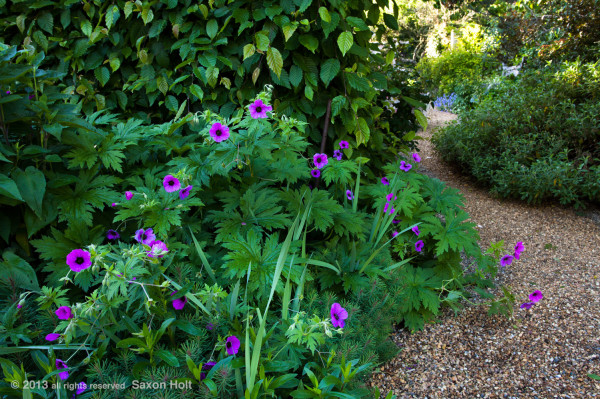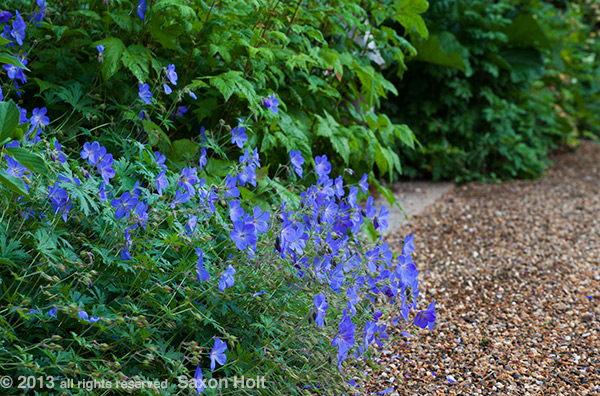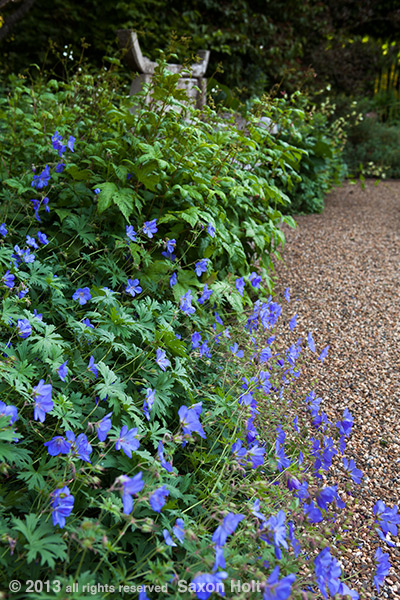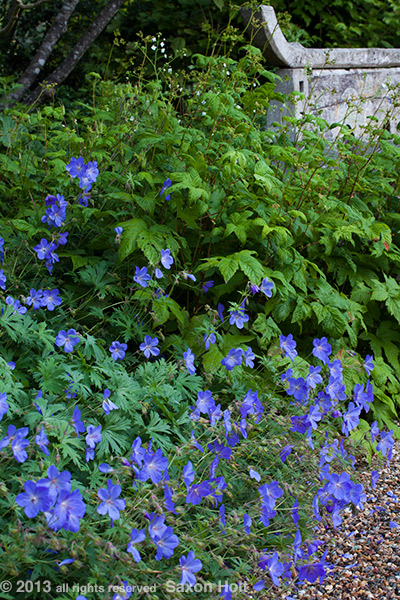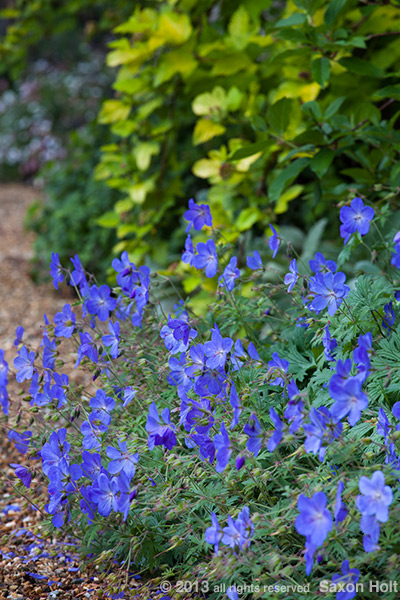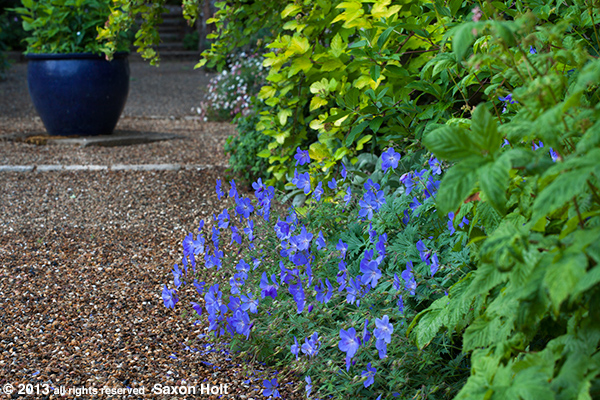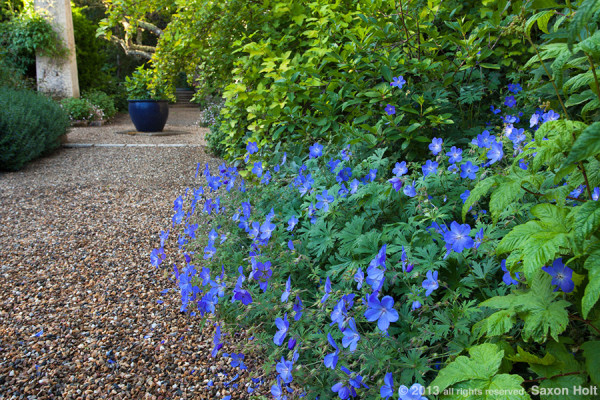When faced with overwhelming choices in beautiful gardens, it is almost essential for garden photographers to give themselves a target, an assignment. These days, I am stalking geraniums.
True, it is great to wander around a wonderful garden, drinking in beauty, grabbing shots, but too often such photos end up as snapshots without a story to tell. They may remind you, the photographer, what you saw, but don’t communicate to others.
So, when my friend, Robin Parer, unarguably one of the of the world’s authorities in geraniums and owner of Geraniacea Nursery, told me she was finally doing a book, I had the excuse for an assignment.
When I realized my friends Deborah Wigham and Gary Ratway of Digging Dog Nursery, with unarguably some of the world’s best perennial borders, had many of Robin’s geraniums in those borders, a match was made in garden photography heaven.
An excuse to go make photos: follow me along as I stalk one geranium in this fantastic garden.
And, for this lesson in The PhotoBotanic Garden Photography Workshop, (3.5 -Themes), make an assignment out of your next garden shoot. Choose a feature of the garden, its style, or theme, and tell a garden story. And think like a gardener, trust those instincts that inspire you as a garden photographer.
Geraniums are hard to photograph. The very feature that makes them so valuable in the garden – lax, sprawling fillers with delicate leaves and ephemeral flowers, makes them hard to isolate and distinguish in a photograph. So I was delighted to find this specimen in full flower, glorious ‘Johnson’s Blue’.
Spilling out of the mid border onto a gravel path with nothing else in flower around it, for interest, I tried a vertical shot to bring in an old bench half hidden in the foliage.
I am kneeling on the path with my tripod as low as it goes using a wide angle lens almost on top of the geranium. Another way of composing a vertical with the bench is to use a longer lens.
Again, a low angle, but backed away so that the telephoto lens can get close to the flowers while stacking up the other elements as shapes in the composition.
This is the classic way to “work” a garden photo, trying different techniques, thinking of different ways to present the story; and why having an assignment allows the photographer to think about every angle and every way to capture the subject. You slow down to really see the subject and its surroundings, deciding which elements need to be part of the story you want to tell.
Let’s look back at the geranium, down the path the opposite way:
Almost exactly the same relative composition – the geranium carries about the same space in the frame, but this photo is all about the blue geranium in context of the chartreuse foliage of its neighbor.
I am now back the next morning, still walking in circles around the garden, coming back to this border, stalking ‘Johnson’s Blue’, not wanting to miss any new photo opportunity. The light is much changed.
Now shooting the other direction, I am able to incorporated an urn in the path. The light is not murky like it was the afternoon before.
Hmmm… How about even wider lens ?
Aha. I think I have something here for Robin’s book. I like all the photos for different reasons, but this one really shows how to use this geranium, its scale and habit, its color and companions, its place in an authentic garden.
It took hours, even days to “see” this. But without the assignment, to force me to keep looking, I doubt I would have come up with what I consider a calendar quality photo.
That is the goal of this lesson, indeed this entire PhotoBotanic Garden Photography Workshop. Striking pictures don’t just happen, even if you think you see them. If you take garden photography seriously you need to work at it. Put all the techniques you have learned into practice with an assignment, a theme you understand and want to tell a story about. “Work” the scene.
There is always the fear you will miss something even more glorious if you stay on assignment in only one part of a garden, but the bigger fear is to miss the moment when the assignment subject looks its best. You want that calendar shot, not lots of snapshots. Stay on task.
Indeed, more likely staying on task will give even more insight on the garden you are studying, and give you other photos you would have never seen.
If I weren’t down at ground level studying ‘Johnson’s Blue’ I would never have seen how this Carex pendula works. See the blue beyond ? Ahh, right. I only got to see the Carex shot because I kept looking for ways to see the geranium I was stalking.
And in the very first photo of this post ? See way beyond the magenta geranium, along the path into the other garden room? Aha; again that same ‘Johnson’s Blue’.
There are many ways to give yourself an assignment. Think like the gardener inside you to find a theme that interests you, that will inform your photography. Are you good at propagating, do you know good color combinations, love foliage, feel attuned to seasons, enjoy design, marvel at trees? Use a theme, go shoot.
As you get more comfortable telling stories, you will be able to juggle multiple themes during a shoot, always thinking about what you are seeing and how it relates to one story or another that you can tell.
While at Digging Dog Nursery, thinking about blue geraniums it was easy to see how Gary used other blue flowering perennials, such as Nepeta ‘Walker’s Low’.
Now if my assignment had been “blue in the garden” I would have shown you a different set of photos….

